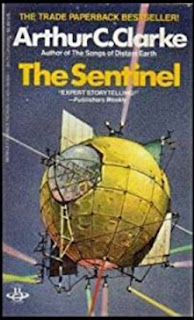2001: A Space Odyssey
2001: A Space Odyssey is a 1968 epic science fiction film inspired by the book of short stories "The Sentinel" by Arthur
C. Clarke and his other short stories. The film follows a voyage to Jupiter with the sentient computer
HAL after the discovery of a slab-sided alien monolith affecting human evolution, and features themes existentialism, human evolution, technology, artificial intelligence, and the possibility of extraterrestrial life.
The
film is noted for its scientifically accurate depiction of space flight, pioneering
special effects, and ambiguous imagery.
The
film received diverse critical responses ranging from those who saw it as
darkly apocalyptic in tone to those who saw it as an optimistic reappraisal of
the hopes of humanity. The film garnered a cult following and became the
highest-grossing North American film of 1968. It was nominated for four Academy Awards. Director Stanley Kubrick won the award for his
direction of the visual effect.
In
1991, it was deemed "culturally, historically, or aesthetically
significant" by the United States Library of Congress and selected for preservation in
the National Film Registry. In 2010, it was named the greatest film of
all time by The Moving Arts Film Journal.
Filming began December 29, 1965, in Stage H at Shepperton Studios, England. In January 1966, the production
moved to the smaller MGM-British Studios in Borehamwood, where the live-action and special-effects filming was
done, starting with the scenes involving Floyd on the Orion spaceplane; it
was described as a "huge throbbing nerve center ... in which the same
frenetic atmosphere as a Cape Kennedy blockhouse during the final stages of
Countdown."
For
the opening sequence involving tribes of apes, professional mine
Daniel Richter played the lead ape and
choreographed the movements of the other man-apes, who were mostly portrayed by
his mime troupe.
Added note
The shots where
the actors appear on opposite sides of the wheel required one of the actors to
be strapped securely into place at the "top" of the wheel as it moved
to allow the other actor to walk at the "bottom" of the wheel to join
him. The most notable case is when Bowman enters the centrifuge from the
central hub on a ladder, and joins Poole, who is eating on the other side of
the centrifuge. This required Gary Lockwood to be strapped into a seat while
Keir Dullea walked toward him from the opposite side of the wheel as it turned
with him.


































